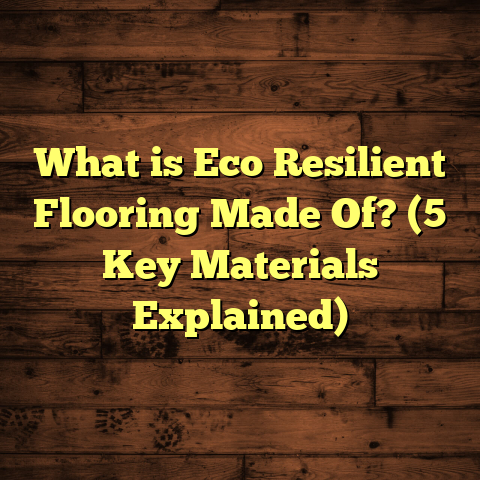What Is Granwood Flooring Made Of? (7 Key Ingredients Uncovered)
What if I told you that a flooring option, often overlooked, combines beauty, durability, and sustainability? Granwood flooring is one of those hidden gems that can make a space feel unique while standing the test of time. When I first came across Granwood, I was intrigued by its composition and characteristics. So, let’s dive into what makes this flooring so special and uncover the seven key ingredients that contribute to its distinct nature.
The Ingredients That Make Granwood Flooring Shine
1. Wood Fiber
At the heart of Granwood flooring is wood fiber, which creates a basis for its structure. The fibers come from recycled wood products, providing an eco-friendly aspect that many homeowners appreciate. I remember working on a project in a local school where the administrators emphasized sustainability. Granwood was the perfect choice due to its recycled content and overall durability.
Granwood’s use of wood fiber not only supports environmental efforts but also adds to its aesthetic appeal. The fibers are crafted in such a way that they retain a natural appearance, closely resembling traditional hardwood floors. This makes it an appealing choice for those who want the look of wood without the high price tag or maintenance associated with solid hardwood.
2. Resin
Resin binds the wood fibers together, contributing to the flooring’s strength and resilience. This element is crucial because it helps the flooring resist wear and tear over time. During a renovation at a community center, I noticed how well the Granwood stood up against heavy foot traffic, thanks to the resin’s properties.
The resin used in Granwood flooring is often formulated to be both durable and flexible. This means that while it provides a strong bond, it also allows for slight movement within the flooring, which can help prevent cracking or breaking under pressure. In previous installations, I’ve seen how this flexibility can be particularly beneficial in areas with fluctuating temperatures or humid conditions.
3. Mineral Additives
Incorporating mineral additives into Granwood not only enhances its durability but also improves resistance to moisture and temperature fluctuations. The minerals help stabilize the structure, making it less likely to warp or swell. While working in a coastal area with high humidity, I was thrilled to see how well Granwood performed in those conditions.
These mineral additives also play a role in sound absorption. In spaces like schools or offices where noise reduction is desirable, the addition of minerals can help create a quieter environment by dampening sound transmission through the floor. I had a client who was particularly concerned about noise levels in their newly renovated daycare center; they were delighted with how effective Granwood was in minimizing distractions.
4. Color Pigments
One of the exciting aspects of Granwood is its color versatility. Manufacturers add color pigments to create a wide range of aesthetic options. When helping a client choose flooring for their new restaurant, we were able to find the perfect shade that complemented their design vision while ensuring it would withstand spills and stains.
The ability to customize colors means that no two installations need to look alike. Whether you’re aiming for a modern, sleek look with dark hues or a more rustic vibe with lighter shades, Granwood has options to fit every style. Additionally, these color pigments are designed to be UV resistant, which means they won’t fade quickly when exposed to sunlight, maintaining their vibrancy over time.
5. Backing Material
The backing material is another critical component that contributes to the overall performance of Granwood flooring. This layer adds stability and support, making installation easier. I often recommend using a quality underlayment to enhance sound absorption and comfort, especially in multi-family dwellings where noise can be an issue.
A well-constructed backing not only improves stability but also helps with insulation. In colder climates, having a good backing material can prevent cold air from seeping through the floor, making your home more comfortable and potentially lowering heating costs during the winter months.
6. Finish Coatings
Granwood often features multiple finish coatings that protect against scratches and scuffs while adding an appealing sheen. I’ve seen firsthand how easy these finishes make maintenance. A quick sweep or mop usually does the trick, keeping the floors looking brand new for years.
These finishes are typically applied in several layers during manufacturing, ensuring that they provide long-lasting protection against everyday wear and tear. In one memorable project for a bustling café, we installed Granwood flooring with an enhanced finish that made cleaning up coffee spills a breeze—no staining or lingering odors!
7. Environmental Certifications
Finally, many Granwood products come with environmental certifications, ensuring they meet specific sustainability standards. For instance, I recently worked on a project where the client wanted all materials to be LEED certified. Granwood fit perfectly into their eco-friendly goals, contributing points toward their certification.
These certifications are not just marketing gimmicks; they reflect genuine efforts to create environmentally friendly products. Many consumers today are increasingly aware of their environmental impact and prefer products that align with their values. The certifications associated with Granwood give customers peace of mind knowing they’re making responsible choices.
Installation Insights
Now that we’ve covered what Granwood is made of, let’s talk about installation. The process is relatively straightforward and can be handled by most DIY enthusiasts or professionals alike.
When installing Granwood flooring, I recommend starting with a clean and dry subfloor. Proper acclimation of the product is also vital—allowing it to adjust to the room’s temperature and humidity for at least 48 hours before installation helps prevent future issues.
Installation Tips:
- Use a vapor barrier if you’re installing over concrete: This helps prevent moisture from seeping up into your flooring.
- Consider using a floating installation method: This method allows for easier replacement in the future without damaging your subfloor.
- Don’t forget expansion gaps around the edges! This allows for natural movement as temperatures fluctuate.
I’ve installed Granwood in various settings—homes, schools, cafes—and each time, following these installation tips has led to successful outcomes. When I worked on installing Granwood in a high-traffic school hallway, ensuring proper expansion gaps helped avoid issues later on as students rushed through.
Maintenance Made Easy
One of my favorite aspects of Granwood is how low-maintenance it is compared to other flooring types. Regular sweeping and occasional damp mopping are usually sufficient to keep it looking fantastic.
If you’re dealing with spills or stains (which happens!), act quickly to wipe them up with a clean cloth and a gentle cleaning solution recommended by the manufacturer.
I once had a pet owner reach out to me after their dog had an accident on their Granwood floor. They were worried about damage, but after following a simple cleaning process, the floor looked as good as new!
Maintenance Tips:
- Avoid harsh chemicals: Stick to pH-neutral cleaners specifically designed for your flooring type.
- Use area rugs in high-traffic zones: This not only protects your floors but can also add to your decor.
- Regularly check for scratches: If you notice any minor scratches or scuffs, consider using wood touch-up markers designed for engineered wood products.
By keeping these maintenance tips in mind, you can ensure that your Granwood flooring remains beautiful and functional for years to come.
Cost Considerations
When it comes to budgeting for your Granwood flooring project, understanding costs can be daunting. This is where tools like FloorTally come in handy for me. It helps calculate precise cost estimates based on local material and labor rates, which streamlines my planning process significantly.
With FloorTally, I can visualize total costs associated with my projects easily, including necessary materials and any potential waste factors. This way, I can provide clients with realistic budgets upfront—something that fosters trust and transparency.
Cost Breakdown:
- Material Costs: Typically range from $3 to $7 per square foot depending on the design and finish.
- Installation Costs: Professional installation can add another $2 to $5 per square foot.
- Additional Costs: Don’t forget about underlayment or other materials that might be needed during installation.
In one recent project for a local gym looking to renovate their floors, we used FloorTally to lay out all potential costs clearly. This helped us stay within budget while still achieving their goal of durable and attractive flooring.
Real-Life Experiences
Let me share a quick story about a recent renovation I completed in a bustling coffee shop. They wanted something durable yet stylish and decided on Granwood flooring due to its unique look and easy maintenance. After installation, they received numerous compliments from customers admiring the aesthetic appeal while also noting how easy it was to keep clean during peak hours.
A few months later, they reached out again for advice on expanding their space because they loved the flooring so much! This kind of feedback reaffirms my belief in choosing Granwood for commercial spaces.
Another interesting project involved installing Granwood in an upscale restaurant kitchen where spills were frequent. The owners were initially concerned about how well it would hold up against grease and food stains. After several months of use, they were ecstatic about how easy it was to maintain—just some warm soapy water did the trick!
Design Versatility
Granwood’s design versatility allows it to blend seamlessly into various interior aesthetics—from modern minimalist spaces to rustic charm homes. When working on design projects, I often encourage clients to think beyond just functionality; aesthetics matter too!
Matching Your Decor:
- Modern Spaces: Choose darker shades or sleek finishes for a sophisticated look.
- Rustic Homes: Lighter tones or distressed finishes can add character and warmth.
- Commercial Areas: Opt for colors that can hide dirt or stains but still maintain an inviting atmosphere.
In one residential project focusing on creating an open-concept living area, we chose a medium-toned Granwood that complemented both the kitchen and living room beautifully. The homeowner was thrilled at how well it tied everything together while providing durability for their active family life.
Environmental Impact
With increasing awareness about sustainability, many homeowners are looking for options that align with eco-friendly practices. Granwood’s use of recycled materials positions it as an environmentally responsible choice in flooring.
Benefits of Choosing Eco-Friendly Flooring:
- Reduced Waste: By using recycled wood fibers, Granwood helps lower landfill contributions.
- Sustainable Production Processes: Many manufacturers adhere to environmentally friendly practices throughout production.
- Energy Efficiency: Properly installed flooring can improve insulation in homes, leading to lower energy costs over time.
I once consulted with a couple renovating their home who wanted every aspect of their project to reflect sustainability. Choosing Granwood helped them meet their goals without sacrificing style or performance.
Conclusion
Granwood flooring stands out not just for its impressive composition but also for its performance in real-world applications. With key ingredients like wood fiber, resin, and mineral additives working together, it provides durability and aesthetics that are hard to beat.
Whether you’re considering it for your home or a commercial space, remember its low-maintenance appeal and eco-friendly aspects make it an excellent choice for various environments.
So next time you’re pondering your flooring options, think about how Granwood could be the perfect fit! If you have any questions or want to share your experiences with Granwood or other flooring types, feel free to reach out!





